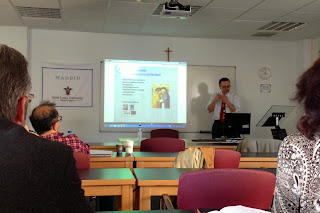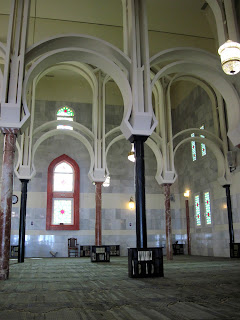This last week or so was quite busy, as I worked with Jessica in the finance office to finalize the non-academic details of the conference - the materials, the location, the budget, the meals and coffees, etc. Until the conference got close, I had kind of been waiting for Paco or Damian to tell me how I could be helpful, but they already had enough on their plates and hadn't given me much to do specifically. So in the last two weeks, as the conference was fast approaching, I took more initiative and contacted Jessica in administration. We sat down a couple times together, solved all the unsolved problems, and finalized all the last details. Together we finally got the programs, flyers, name tags, and posters printed; the welcome information and directions sent out to the arriving guest speakers; the transportation and reimbursements figured out; reservations and payments for meals confirmed; and the snacks purchased and the different coffee and tea breaks arranged (who would have thought that two coffee breaks were going to be harder to organize than the lunches and dinners combined!). It was busy and it felt really good to be helpful in getting all those things finalized and taken care of. At one point Jessica turned to me and said "Are you sure you're an academic? You don't seem like one - You seem like one of us!" It was the best/weirdest compliment of my organizational skills, ever. I attribute these limited event-planning skills to my years in PAAC, Dark Purple, and Slick Shoes back in my Cornell days. :-)
Getting folders assembled
When the weekend finally arrived, we had a student worker Tara helping too, which was great, because I definitely needed some back-up. I was at the main building, welcoming the scholars, passing out folders, and directing them to the location of the conference, while she was at the other building, directing anyone who had showed up there by mistake over to me at PRH 8. Scholars either arrived late because they'd gotten a bit lost, or because they had shown up on 'Spanish time' - aka, late. We got started with the opening remarks at 11, rather than 10:30, and spent most of the weekend moving through our schedule always just about half an hour late, which ended up being fine.
Programs and nametags, ready to go!
In the morning, we heard from Adeline Rucquoi, Damian Smith, and Robin Vose, so we started the conference with a bang. All the papers were really interesting! It was entertaining that right away in the first paper, as I was pushing the limits of my knowledge of Spanish to follow Dr. Rucquoi's paper, which was on Dominic's early life, I heard her cite the work of Kyle Lincoln, one of our SLU grad students! At first I was like "did I hear that right?" but then she mentioned his research another time later on, so that was definitely pretty cool. Damian's paper was on Ramon de Penyafort, emphasizing our need to recognize and understand his powerful influence in the thirteenth century world. Plus his jokes about medieval lawyers went over well. Dr. Vose's paper on the early inquisitors was really well done too, so I found the whole first session quite fascinating.
That afternoon we had lunch at Gino's. The food was amazing, and I got to sit near Dr. Burman and talk about my dissertation prospectus and hear his thoughts on Ramón Martí which was such a treat for me. I can already tell consulting with him as I move forward on my dissertation work is going to be a really good experience. He's a very kind and humble man, and seemed as excited to hear my ideas as I was to hear his, which I really appreciated. I also sat near some of the younger female scholars, and it was lovely to hear their stories on dissertation research and their developing careers. They were enthusiastic about both their research and their teaching, which was both inspirational and helpful, as they had plenty of advice and ideas to share.
Sessions two and three in the afternoon, punctuated by a coffee break, were equally as enjoyable as the morning had been. My favorite papers were from Dr. Chubb, who was looking at Valencian Dominican art and had a lot of beautiful images to share; Dr. García-Serrano, who spoke on the friars, nuns, and the economy among the medieval Dominicans in Castile; Dr. Burman's paper comparing and contrasting Ramón Martí's and Riccoldo da Monte di Croce's polemical approaches to Islam (so fascinating!); and Dr. Jones's paper on Christian and Muslim preaching.
Dr. García-Serrano giving his paper, "Friars and Nuns: Dominican Economy and Identity in Medieval Castile"
Dr. Burman presenting "Ramón Martí and his Arab Books"
Later, after drinks and a break, was dinner at Paulo, a fancy place that's a bit tucked away, near campus. It was a long and delicious dinner, in which Paco told me lots about the Spanish Civil War, which was really interesting, especially after hearing about it from my host family as well. I've learned as much more about modern Spanish history than I had expected during this trip! Because Damian and Paco each had to leave early, I stayed until the very end of dinner, made sure the bill was settled, and walked the remaining merry group back to the metro.
The next day was like, 68 and sunny - a beautiful day for a conference!
Patio at SLU Madrid, Saturday morning
I met Tara bright and early at Trujal to pick up the coffee, milk, and water for tea, and then we set up the coffee service. Then I got to sit out in the bright morning sun and wait for our speakers to arrive. We started late, again, as was expected.
Waiting outside SLU Madrid for professors to arrive
The Saturday papers were also enjoyable. A lot more of them were in Spanish - some were very easy for me to follow, and some were quite difficult for me to understand. It really just depended on the speaker. We had lunch at Ferro's, one of my favorite places, and I talked more with Emily Graham and Taryn Chubb about teaching the middle ages.
In the afternoon session, I particularly enjoyed Dr. Vargas's presentation about the need for historians to collaborate, and incorporate recent technological advances for modeling change. He had a lot of interesting propositions about the potential value of such work for understanding the Dominicans, and his presentation certainly stirred up quite a bit of conversation during questions time.
The conference technically ended at 6pm, after which I had a lot of break-down work to do, but the fun of the weekend didn't stop there. When I was returning the coffee canisters to Trujal, I ran into many of the attendees having a drink there, and was invited to join them. I sat with Emily Graham and Linda Jones, and when it was time to leave Trujal they were trying to sort out plans for the evening, and I got included in that, which was wonderful. I was thinking they'd want to spend the last hours of the weekend working at the library or something, but they actually wanted to do some shopping and then grab dinner. I was able to help them locate the stores they were looking for, and suggested Balmori for dinner, which went over very well. I enjoyed joining them for a bit of shopping, because it was so nice to see that esteemed professors are still real people, who are just as happy discussing flower scents while stopping in a little Perfumeria or Spanish cuisine at length over our dinner at the Asturian Cider House as they are their research. I had so much fun spending the evening with both of them after the conference.
It was the perfect ending to the weekend, and highlighted the benefits of such a small conference - by the end of the two days everyone had gotten to know everyone else fairly well, which is so beneficial for future collaboration and conversation. I heard from so many of the presenters how much they enjoyed the small and intimate size of the conference, which allowed conversations from one morning to continue into lunch, and be brought up again over coffee the next day. It allowed me to actually get to know people and their research and ideas, rather than just exchanging contact info and disappearing into the crowds like at larger conferences.
All in all, the conference was a success - it was exhausting and fascinating!






















